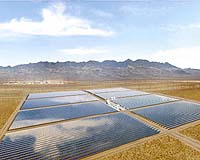 |
Rabat, Morocco (UPI) Mar 24, 2009 North Africa is taking a shine to solar power in a big way, with plants slated for Morocco and Tunisia as a German-led consortium pushes ahead with the world's most ambitious solar project in the Sahara Desert. The $555.3 billion Desertec project is designed to turn the Sahara's endless sunlight into carbon-free electricity that will supply 15 percent of energy-hungry Europe's power and lessen its dependence on natural gas from Russia. Separately, the Moroccan government hopes to invest $9 billion in a solar energy program over the next decade. This means big-ticket contracts could be up for grabs from major European, mainly French energy concerns, such as GDF Suez; oil giant Total; Areva, which specializes in building nuclear plants, and St. Gobain which manufactures mirrors and photovoltaic panels. Paris's Maghreb Confidential online newsletter says the French were lining up to join the program when Moroccan Energy Minister Amina Benkhadra presented her investment program to her French counterpart, Jean-Louis Borloo, March 8-9 in Paris. The centerpiece of the Moroccan plan is a Franco-Moroccan solar power plant generating 20-40 megawatts and exporting up to 4 MW to France. That's a relatively modest project. But the Moroccans are hoping that it will lay the groundwork for more ambitious projects that will boost solar power exports to Europe and beyond. One project being mooted for Morocca's Solar Plan is a 500MW solar power station and at least nine international companies are bidding. They include Nexant of California and Fichtner Solar of Stuttgart, Germany, which has won contracts to design power plants at Ain beni Mather in Morocco, Hassi R'Mei in Algeria and Kuraymat in Egypt. In neighboring Tunisia, the government unveiled a solar plan in late 2009 that includes some 40 renewable energy projects, such as thermo-solar photovoltaic power plants, with a cost of $2.67 billion. Desertec is by far the most complex of all the solar projects currently under way. It is still in the planning stage and construction isn't expected to begin for another 2-3 years. It has big-name partners, such as Deutsche Bank and Siemens, and is still attracting new companies, such as First Solar, a U.S. photovoltaic company that has constructed utility-scale solar plants in the deserts of the United States and the United Arab Emirates. Using a method known as concentrated solar power it would generate inexhaustible and affordable quantities of energy across the Mediterranean -- and even on a global scale if necessary. One of its big attractions is that it would emit no carbon dioxide, making it the world's biggest green-energy project. If Desertec does get off the ground, it would be the largest green-energy project on the planet. In theory, a global system of solar thermal power would also eliminate the prospect of resource wars erupting in the years ahead as the planet's natural resources that currently produce energy -- oil, gas, coal, timber and water -- disappear. The idea for this massive project to harness the sun's energy on a gigantic scale originated with a group of European scientists and politicians called the Trans-Mediterranean Renewable Energy Cooperation. The concept of large-scale solar power has been around for some time but was never able to make the breakthrough because of cheap oil. Desertec's backers believe it will open the door to a new era of environmentally friendly generated power on a massive scale. That would keep Europe at the forefront of the struggle against climate change and help North African and European economies to expand within the limits of greenhouse gas emissions. Its critics caution that there are numerous pitfalls, among them the vagaries of North African politics and the perception that European projects like Desertec is just another form of economic plundering by the old colonial powers. According to Nature magazine, the solar-cell market has been growing by an average by 31 percent a year for the last decade, and enthusiasts predict a 20-25 percent growth rate in the next few years. Every year, the sun produces 630,000 terawatt hours -- a terawatt equals 1 trillion volts -- of energy in North Africa that is untapped. Europe consumes 4,000 terawatt hours of energy a year. That's only 0.6 percent of the unused energy that falls on the North African desert.
Share This Article With Planet Earth
Related Links All About Solar Energy at SolarDaily.com
 Environmentalists question solar plants
Environmentalists question solar plantsLas Vegas (UPI) Mar 23, 2009 "Environmentally friendly" solar power plants planned for Nevada and around the U.S. Southwest may in fact devastate the local ecology, opponents say. The problem, environmentalists say, is that tens of thousands of acres of untouched desert will have to be bulldozed for utility-scale solar plants, threatening rare and endangered plants and animals, the Las Vegas Sun reported Tuesday. / ... read more |
|
| The content herein, unless otherwise known to be public domain, are Copyright 1995-2010 - SpaceDaily. AFP and UPI Wire Stories are copyright Agence France-Presse and United Press International. ESA Portal Reports are copyright European Space Agency. All NASA sourced material is public domain. Additional copyrights may apply in whole or part to other bona fide parties. Advertising does not imply endorsement,agreement or approval of any opinions, statements or information provided by SpaceDaily on any Web page published or hosted by SpaceDaily. Privacy Statement |